Your Backyard Wildlife Habitat: What Else is In Your Backyard, The Fauna That Fill It
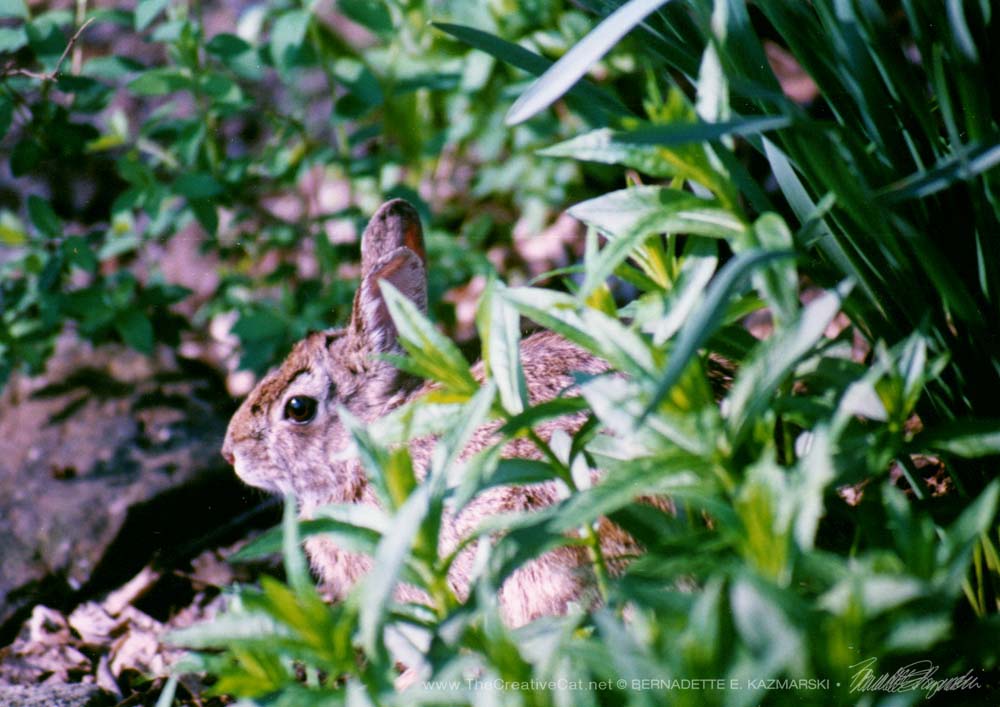
This is the third in a series of four articles about considering your backyard wildlife habitat.
One lovely August morning I was harvesting tomatoes in my vegetable garden. The air was pleasantly warm and the garden was still dewy as I crept along, crouching between the tall beefsteaks, picking the newly-ripened tomatoes at the bottom of each plant.
I reached around the base of one plant to get to a tomato in the back and felt a tickly spiderweb on the back of my hand, pulled my hand back and saw A HUGE BLACK AND YELLOW SPIDER RUNNING UP MY ARM!
I jumped up and shrieked, tossing the spider off my right arm into the air, and holding tightly to the basket of precious tomatoes I vaulted a row of Romas in 30” cages from a standstill and ran out into the middle of the yard where nothing could get me, slapping at my arm and shaking myself.
Most of what lives in your backyard you will never see, or never notice, unless you go poking around into their protected little habitats, and it’s there for a reason. Even though I pictured something that had legs as long as railroad crossing bars, it was just a common garden spider, and perfectly harmless to me—but deadly to most of the tiny flying insect pests that might decide to munch on my tomatoes. I hope it didn’t mind being relocated in such an ingracious way.
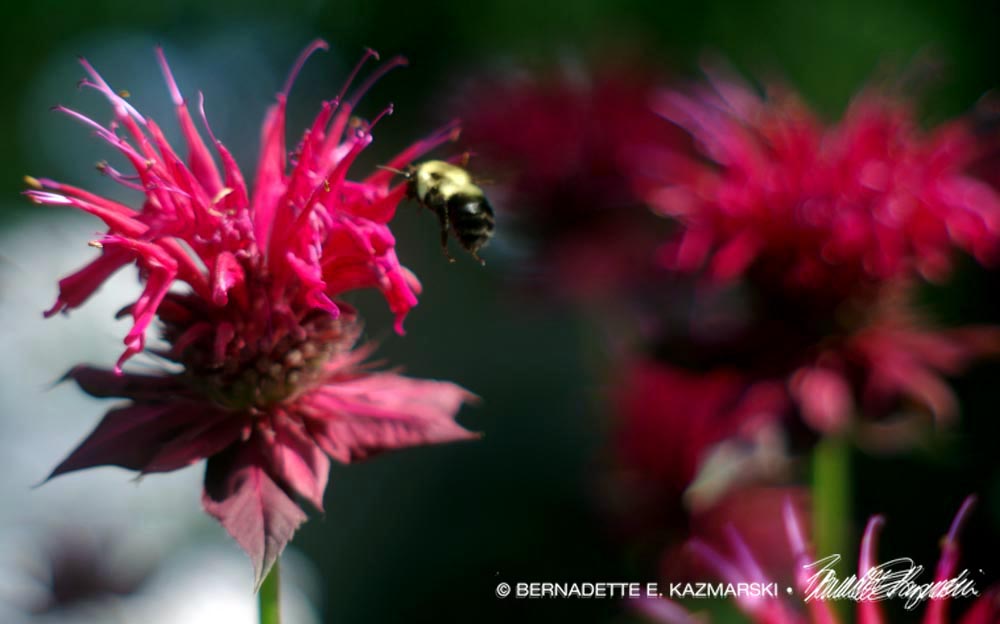
Finding your residents
Birds are obvious, and are often the reason people consider backyard wildlife habitats, and butterflies have become very popular now that people have realized they can actually attract them with specific plants.
Wild rabbits are generally welcome, squirrels can’t be avoided, and the most dedicated even put up with groundhogs, raccoons, opossums, deer and plenty of other species depending on where you live (you can tell I’m in the northeast) as long as they aren’t predators and don’t pose danger to humans or other animals.
Not too many people consider arachnids, amphibians, reptiles or even less-obvious mammals, like bats. But a certain number probably already live quietly in your habitat, and for a good balance you would want to consider attracting more.
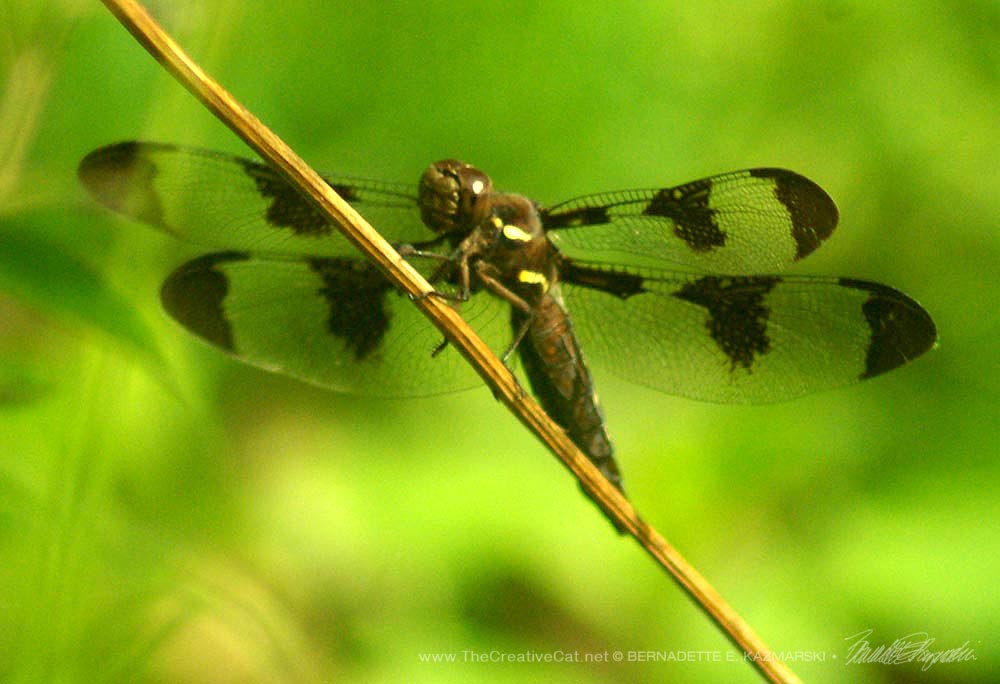
General categories
Start by considering these categories:
- birds
- mammals
- insects/invertebrates
- fish
- amphibians
- reptiles
And again, like your diagram and plant species list, organize it in the way you are most comfortable with your computer or a notebook or little scraps of paper you can organize later.
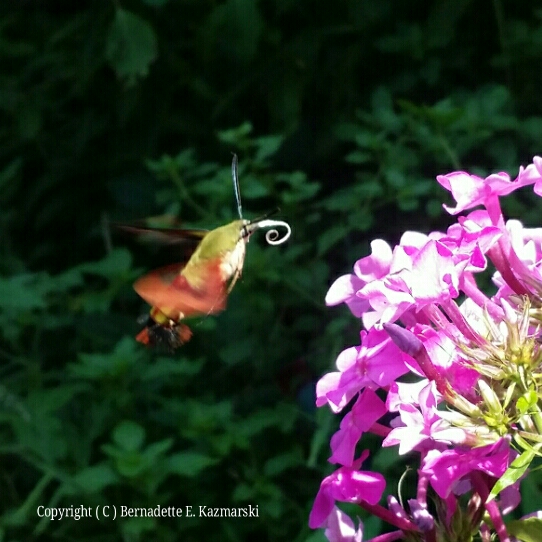
Identifying your species
Unless you’ve been observing wildlife or have some training in the field, this is going to be the hardest part of assessing what you have to work with, in no small part because you may not even know what is supposed to be there and what it may look like.
Don’t stumble on this. You can either just identify what you know and learn the rest later, or begin applying yourself now to learning what could be there and then going to look for it.
For plants I listed three guidebooks for my region. For this section I have only one book, to identify birds, A Field Guide to the Birds East of the Rockies, written and illustrated by Roger Tory Peterson, Houghton Mifflin Company, Boston, 1981. You just flip through the book looking at the illustrations until you find the one that looks like the bird you saw in your yard. It can seem tedious, but before you know it you’ll become familiar with the book and be able to flip to the image you are thinking of much more quickly.
For other species I now hop on the internet or ask a few friends and colleagues who are knowledgeable about individual species for quick introductions. For more detailed information I visit the Audubon center or the zoo. Descriptions can be tricky, “I saw this big blue bug, and it had wings…” so take notes on what you see and take a photo if possible.
The easiest category to cover would be fish, because unless you have a backyard pond, which you have stocked, or live next to a body of water that has fish in it, which is probably monitored by a county or state fish or game agency, you can be reasonably certain that no fish are hiding under your forsythia.
The species of reptiles and amphibians that could live in a backyard, or even a slightly more extensive, habitat is limited, so you can find a list of what is native to your area and determine whether or not you have the right habitat for that species. For these species especially I usually have to find a scientist friend and describe what I’ve seen, or ask for a list of what I should look for. In any area of the country you’d at least be looking for frogs or toads, turtles, snakes, salamanders and lizards.
The number of insects that could be living in your backyard is seemingly endless. This category includes butterflies, which you may also want to attract, and obvious species such as bees and dragonflies, which are familiar and easy to find, and pests like Japanese beetles and aphids, which attack a plant and don’t let go until it’s dead. Again, the internet is a great resource, but a local reference person can tell you what you should look for.
Mammals can vary greatly from one region to another and in urban, suburban and rural areas. Some species, like foxes and coyotes, haven’t been seen in years, but are making a comeback. Many of the mammals that inhabit your habitat are nocturnal, so you’d never actually see them except by accident in the dark, but you could find their tracks or other traces of them, such as a path through your grass.
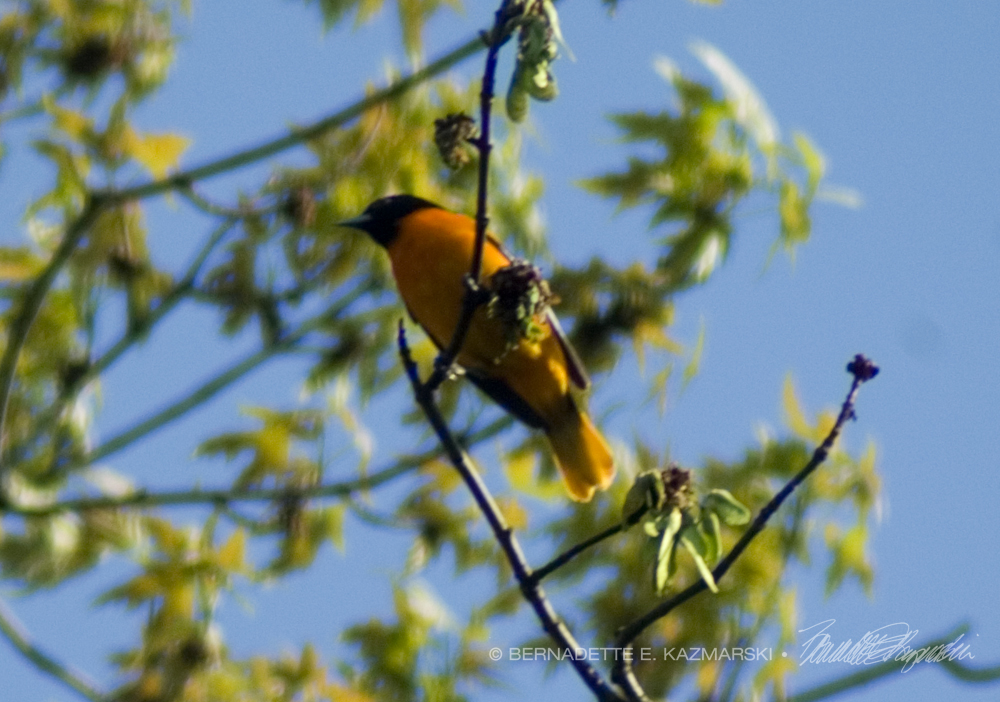
More opportunities to learn
Just as I mentioned with identifying your flora, take your time with this part of the process, too. You will learn so much about your habitat in this way, and not just about what lives there, but how they all work together. This is where the puzzle pieces begin to fit together as you realize that, for instance, many bird species eat insects, and you may or may not have a certain species of bird in your yard because you don’t have a specific insect. And you may be overrun with a certain insect because you don’t have any habitat for spiders, which would keep them under control, even if they would send you screaming on a lovely summer morning.
And, again, the greatest satisfaction is being able to share what you’ve learned with other gardeners. You can become the problem-solver, too.
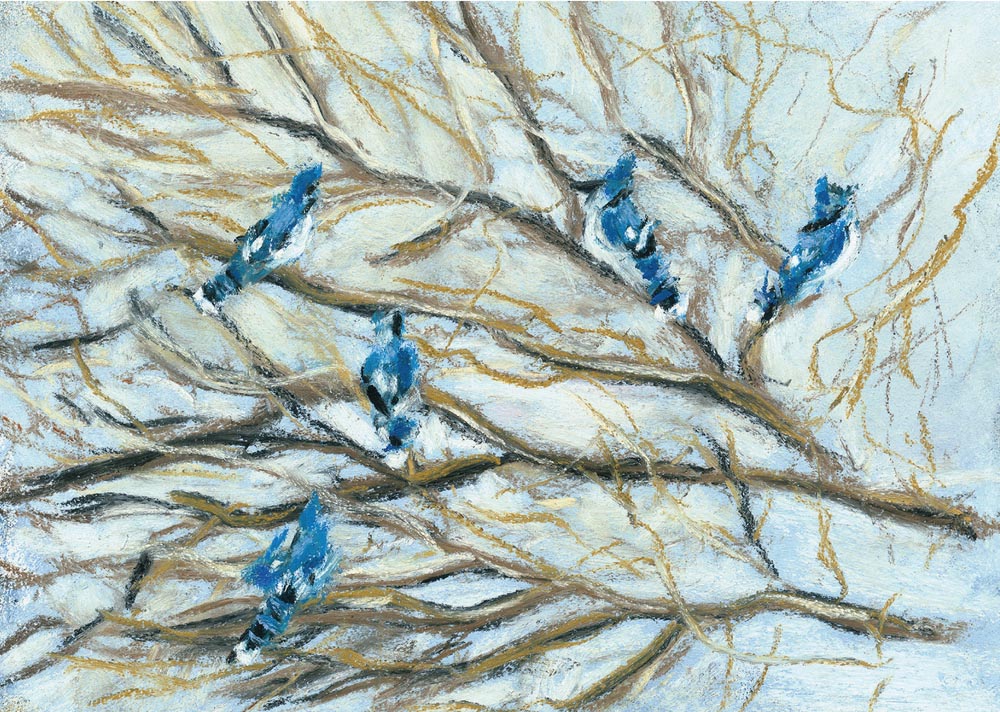
I am inspired by…
I really do photograph, sketch and paint my birds all the time. You can find plenty of posts of my cats watching birds here on The Creative Cat, and also visit my photo blog, “Today”, to see some of my recent photos of birds in my yard and beyond.
Visit the Birds and Wildlife, Gardens and Wildflowers and Nature photo galleries on Portraits of Animals as well as the Wildlife Artwork Gallery to see some of my art inspired by watching the birds at my feeders and the wildlife in my back yard. I’ve featured a number of these photos, sketches and paintings in holiday and greeting cards as well.
And, unintentionally, you can hear them in the background of a few of the poems I recorded, even though one was recorded in early spring when the windows were still closed: “The Gift of a Morning” and “Wild Apples”.
Also read about my art, photography, poetry and prose inspired by my backyard wildlife habitat:
Art Inspired by My Backyard Wildlife Habitat
Photography Inspired by My Backyard Wildlife Habitat
Poetry Inspired by My Backyard Wildlife Habitat
Prose Inspired by My Backyard Wildlife Habitat
Backyard Wildlife Habitats
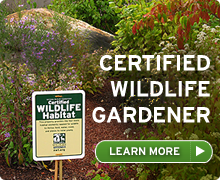
My backyard wildlife habitat was certified through National Wildlife Federation’s program in 2003, and their site is still one of my favorite references for information. Visit and read about it, and begin planning your own and be certified!
. . . . . . .
Read the entire series of introductory articles:
An Introduction to Backyard Wildlife Habitats
What’s in Your Backyard? The First Step in Planning Your Backyard Wildlife Habitat
What Else is in Your Backyard: The Fauna That Fill It
Bringing it All Together: Enhancing and Developing Your Habitat
Or just read other articles in the category of Your Backyard Wildlife Habitat
Gifts featuring cats you know! Visit Portraits of Animals
Fine Art • Photography • Gifts • Greeting Cards • Books • Commissioned Portraits & Artwork
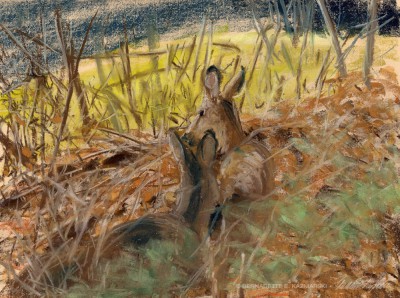
Though they nibble on some of my favorite foods and flowers that grow in my back yard, I enjoy observing the two does who have visited for the past three years, sometimes with their boyfriend and sometimes with a fawn. When I came outdoors they would often leave my vegetable garden and scurry through my woodland garden to the overgrown area between all our yards. Though they were in plain sight of about six houses and all of us watched them, they apparently felt they were safe—and they were, really, because when I looked at the reference photo for this I wondered why I’d taken a photo of the brush at the end of the yard, and then I saw the ears. It was the perfect cover, hidden in plain sight. Read more and purchase.

Copyright
All images and text used on this site are copyrighted to Bernadette E. Kazmarski unless otherwise noted and may not be used without my written permission, although links to your site are more than welcome and are shared. Please ask if you are interested in using and image or story in a print or internet publication. If you are interested in purchasing a print of an image or a product including it, check my animal and nature website Portraits of Animals to see if I have it available already. If you don’t find it there, visit Ordering Custom Artwork for more information on a custom greeting card, print or other item.
Subscribe to my e-newsletter
Subscribe to The Creative Cat Preview E-newsletter.
© 2022 | www.TheCreativeCat.net | Published by Bernadette E. Kazmarski
Weekly schedule of features:
Sunday: Essays, Pet Loss, Poetry, The Artist’s Life
Monday: Adoptable Cats, TNR & Shelters
Tuesday: Rescue Stories
Wednesday: Commissioned Portrait or Featured Artwork
Thursday: New Merchandise
Friday: Book Review, Health and Welfare, Advocacy
Saturday: Your Backyard Wildlife Habitat, Living Green With Pets, Creating With Cats
And sometimes, I just throw my hands in the air and have fun!
PORTRAITS OF ANIMALS WEBSITE
FACEBOOK | TWITTER | LINKEDIN | PINTEREST | TUMBLR | INSTAGRAM | YOUTUBE| EMAIL | PATREON


